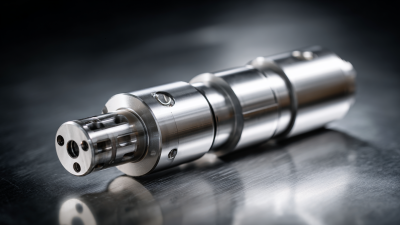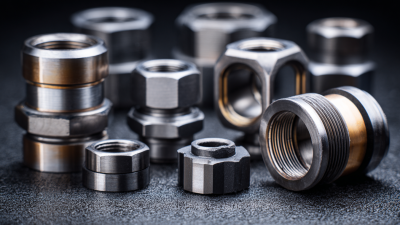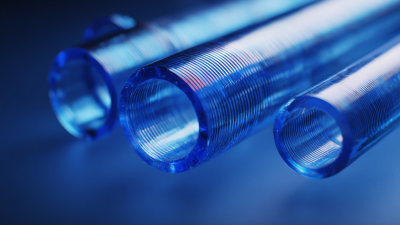Ultimate Guide to PVC Pipe Fittings: Understanding Specifications and Industry Trends for Optimal Selection
PVC pipe fittings are essential components in a variety of plumbing and construction applications, offering durability, versatility, and cost-effectiveness. According to a recent industry report by MarketsandMarkets, the global PVC fittings market is projected to reach USD 9.2 billion by 2025, growing at a CAGR of 5.2% from 2020. This surge in demand is a testament to the increasing adoption of PVC for its lightweight properties and resistance to corrosion, making it ideal for water supply, drainage, and irrigation systems. As industries evolve, so do the specifications and trends surrounding PVC pipe fittings, including advancements in manufacturing techniques and a growing emphasis on sustainable practices. Understanding these aspects is crucial for making informed selections suited to specific project requirements. In this ultimate guide, we will delve into the various types of PVC pipe fittings, their specifications, and current industry trends to help you navigate the landscape of optimal selection.

Benefits of Using PVC Pipe Fittings for Durable Plumbing Solutions
PVC pipe fittings have emerged as a popular choice in plumbing due to their numerous benefits that cater to both residential and commercial needs. One of the most significant advantages of using PVC fittings is their durability. They are resistant to corrosion, rust, and chemical damage, which ensures a longer lifespan compared to traditional materials like metal. This quality makes them ideal for transporting water, wastewater, and various chemicals without the worry of degradation over time.
Furthermore, PVC fittings are lightweight and easy to install, which translates to lower labor costs and reduced installation times. Their versatility allows them to be used in a variety of applications, from drainage systems to irrigation networks. Additionally, the smooth interior surface of PVC fittings minimizes friction, leading to improved flow rates and reduced energy consumption. With the increasing focus on sustainability, using PVC fittings supports eco-friendly practices by reducing the need for frequent replacements and repairs, thus contributing to less waste in landfills.
Cost-Effectiveness: How PVC Pipe Fittings Save You Money
When it comes to plumbing and construction projects, cost-effectiveness is a pivotal factor, and this is where PVC pipe fittings stand out. Research indicates that PVC pipe fitting systems can save contractors and homeowners up to 30% on overall installation costs compared to traditional materials like copper or steel. This reduction is often attributed to the lightweight nature of PVC, which simplifies transportation and handling, leading to lower labor costs during installation.
**Tip:** Before making a purchase, consider the long-term savings that PVC fittings offer. For example, they are resistant to corrosion and chemical damage, ensuring durability that can last for decades without additional maintenance costs. It's not just about the initial expenses; it's also about enduring savings over time.
In light of industry trends, the demand for sustainable materials has soared, driving further innovation in PVC technology. According to a recent market report, the PVC fittings market is projected to grow at a CAGR of 4.5% over the next five years. This trend is largely fuelled by the enhanced performance properties of modern PVC, enabling users to enjoy stronger and more reliable installations at a fraction of the cost of other materials.
**Tip:** Always verify product certifications when selecting PVC fittings, as higher-quality options ensure compliance with safety and environmental standards, offering better performance and longevity to your installations.

Versatility of PVC Pipe Fittings in Various Applications
PVC pipe fittings have emerged as a cornerstone in various industries due to their remarkable versatility. According to a recent report by **BIS Research**, the global PVC pipe market is expected to reach **$62 billion by 2026**, driven largely by the increasing demand for flexible and durable piping solutions in construction, agriculture, and plumbing. PVC fittings provide essential connections in systems ranging from irrigation setups to municipal water supply, demonstrating their adaptability across applications.
In addition to their flexibility, PVC pipe fittings are recognized for their cost-effectiveness and resistance to corrosion. The **American Society for Testing and Materials (ASTM)** highlights that PVC fittings can withstand chemical exposure and have a long lifespan, which is particularly crucial in industrial setups where reliability is paramount. As a result, businesses are increasingly opting for PVC over traditional materials, aligning with the **Global PVC Market Report**, which indicates a **4.5% annual growth rate** in the use of PVC products across various sectors. This trend underscores the integral role that PVC pipe fittings play in modern infrastructure and highlights their potential for future innovations.

Lightweight and Easy to Handle: The Practical Advantages of PVC Pipe Fittings
When it comes to plumbing and construction projects, the choice of materials can significantly impact efficiency and ease of use. One of the most popular options for pipe fittings is PVC (polyvinyl chloride). Not only does PVC offer excellent durability, but its lightweight nature makes it remarkably easy to handle compared to traditional materials like metal. This characteristic allows for quicker installation and reduced physical strain on workers, making PVC fittings a preferred choice for both professionals and DIY enthusiasts.
Another practical advantage of PVC pipe fittings is their resistance to corrosion and chemical damage. Unlike metal fittings, which can degrade over time or leak when exposed to certain substances, PVC maintains its integrity under a wide range of environmental conditions. This durability ensures a longer lifespan and less frequent replacements, which can significantly lower maintenance costs. Additionally, PVC is non-toxic, making it a safer choice for applications involving potable water. As construction practices evolve, the trend toward lightweight, easy-to-handle materials like PVC continues to grow, establishing it as an industry standard for a variety of plumbing needs.
Resistance to Corrosion and Chemicals: The Long-Term Benefits of PVC Fittings
When selecting PVC pipe fittings, understanding their resistance to corrosion and chemicals is crucial. PVC fittings, made from polyvinyl chloride, offer excellent resistance to a wide range of chemicals, making them suitable for various applications in plumbing and industrial settings. These properties not only ensure a longer lifespan for the fittings but also contribute to reduced maintenance and replacement costs over time. The long-term benefits of using PVC fittings include enhanced system reliability and safety.
Tips for Optimal Selection:
- Evaluate Corrosion Resistance: Always check the chemical composition of materials that will interact with your PVC fittings to ensure compatibility and longevity.
- Consider Temperature Ratings: PVC fittings have specific temperature limits. Choose fittings that can withstand the temperature variations in your application to prevent failure.
- Opt for Trusted Brands: Selecting fittings from reputable manufacturers can provide assurance of quality and performance, ultimately leading to better investment outcomes.
Related Posts
-

How to Select the Best OEM Precision Parts for Your Manufacturing Needs
-

The Future of Best Compression Fittings Revolutionizing Global Supply Chains
-

Discover Innovative Examples of Quick And Easy Fittings Solutions
-

Ensuring Excellence in Manufacturing Standards for Best Ppsu Pex Fittings
-

The Future of Innovation in Ball Valve Technology
-

Understanding the Unique Features of Ball Valve Types for Industrial Applications
